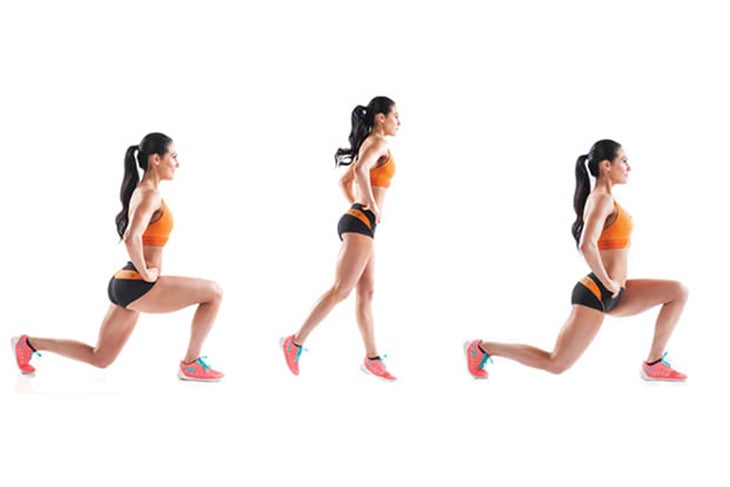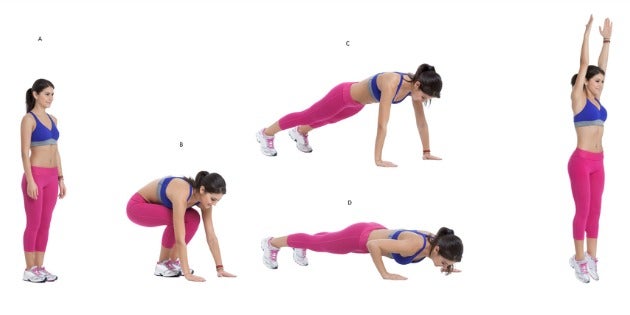Heading out the door? Read this article on the new Outside+ app available now on iOS devices for members! Download the app.
Wouldn’t it be great to work out once and still reap the benefits of burning increased calories hours afterward? It’s not just a dream — it’s called EPOC, or excess post-exercise oxygen consumption, and it’s a very real phenomenon!

What Is EPOC?
In short, our bodies use more oxygen after a workout — an amount in excess of your baseline consumption level — while trying to return itself to a pre-exercise state.
“The best analogy I’ve heard for EPOC is one I read a few years ago,” says Arnit Kobryniec, a certified personal trainer in South Florida who has a master’s degree in psychology, specializing in eating habits and behaviors. “When you use your car and you turn it off, the engine stays warm for a while before cooling off. The same thing happens with your body — once you’re done with an intense workout, your body demands for more oxygen in an attempt to go back to its normal level.”
Here’s the kicker: Because the body is working harder for more oxygen, it causes your metabolism to keep working harder for the rest of the day.
How to Reach an EPOC State
For many, reaching an EPOC effect after workouts is the ultimate goal. Of course, not just any old training session will keep your metabolism revved up and your fat-burning mode engaged for the long haul.
“It comes down to the intensity — the amount of elevation in oxygen consumption — and the duration — the amount of time the consumption of oxygen is elevated — to experience the EPOC effect,” Kobryniec says.
The key is to make the most of your training time during your workout and then sit back and enjoy the EPOC afterburn effect, which can fuel your body’s fat-loss mechanism for up to 24 hours after your workout.
“Different variations of workouts have proven to elevate oxygen compared to steady-state cardio,” Kobryniec says. “These include high-intensity interval training, compound movement training and strength training combined with resistance training.”
DIY EPOC Exercises
Since it’s not about the exact movements you’re doing but more about the intensity and duration of those movements, the sky’s the limit when it comes to structuring your workouts to achieve an EPOC afterburn. As long as your level of intensity is kicked into high gear, it’ll cause your oxygen consumption to rise and EPOC will be yours! On the other hand, if you only stick to steady-state cardio, your body will get back to its resting state too quickly.
If you like to set your own workouts, follow this guide for three EPOC-inducing plans:
- HIIT. A good rule of thumb, according to Kobryniec, is to strive for 45 seconds on and 15 seconds of rest (or 30 on/10 off, if needed). Choose five movements and do three rounds of them. “My favorite is 45 seconds on and 15 seconds off,” Kobryniec says. “You end up thinking you’re going to die because 45 seconds feels like such a long time!”
- AMRAP (as many reps as possible). Set a timer for eight minutes. Choose four or five compound movements and a specific set of repetitions for each movement. “The goal is to push yourself so hard that you hit an amount of rounds that are technically impossible to hit. You are constantly pushing until the buzzer goes off,” she says.
- Mixed moves.One more variation includes integrating circuit-training compound moves with resistance bands. Remember, the goal is to take your intensity to the next level.

2 Epic EPOC Workouts
Do you need a little guidance planning your EPOC-inducing workout? Kobryniec shares two of her favorite routines:
HIIT: This workout can be done at home, and all your need is your own bodyweight.
- 45 on: Burpee Into Knee Tuck Jump (15 rest)
- 45 on: Jump Squat to Jumping Lunge (15 rest)
- 45 on: Blastoff Push-Off — From a push-up position, move your lower body toward your feet, bending strongly at your knees. Push your body quickly back into the push-up position, transferring weight into your shoulder region. In a fluid motion, complete a push-up by lowering toward the ground, nose coming close to touching the ground. Press back up to the starting plank position. (15 rest)
- 45 on: Break Dancer — Begin in a plank position. Bend your knees in a 90-degree position, knees aligned below your hips. Hover while engaging your core. Pick your right hand off the floor and drive your left leg through. Keep your chest up, core engaged and weight on your left arm. Come back to center and repeat the movement with the other side. (Rest for 60 seconds.)
Repeat two more times.

AMRAP: Set your timer for seven minutes, and grab some hand weights.
- 10 Renegade Rows (each arm)
- 12 Squats to Shoulder Presses
- 12 Weighted Burpees: Stand with your feet shoulder-width apart, arms by your sides holding weights. Bend your knees and reach forward to place your hands on the floor. Kick your legs straight out behind you and immediately lower your entire body down to the ground, bending at your elbows. Use your arms to quickly push your body back up, and hop your legs back under your body. Jump straight up into the air, arms by your side with weights. End with your knees slightly bent, and go directly into the next rep.
- 10 Sit-Ups to Presses: Lie down on your back. Bend your legs and stabilize your lower body. Hold the dumbbells above on your shoulders. Lift your head and shoulder blades from the ground. Exhale as you rise. As you sit up, press the dumbbells above your head.
“Try to repeat this one more time, but challenge yourself to do one more round than your first try,” Kobryniec suggests. “So if you did four rounds in seven minutes, challenge yourself to do five rounds.”
[KYRA – MAYBE PHOTO OF WOMAN DOING A WALKING LUNGE]
Bonus EPOC Moves
Looking for a little more inspiration to help keep things fresh in the gym? Here are a few more moves to add to your repertoire. Keep in mind that as with any exercise routine, more doesn’t necessarily equal better. These workouts are intense, so start off with a few times a week, with a rest day in between.
Spider Crawl and Walking Lunge
Sure, cardio gives you a decent afterburn effect. If you work at about 85 percent of your max heart rate for 12 to 20 minutes, you’ll certainly bask in the glory of your postworkout EPOC. Of course, not everyone loves running on a treadmill — so if cardio machines aren’t for you but you still want to improve your conditioning, try a crawl-lunge combo: Do the spider crawl for 20 yards, then lunges for 20 yards. Keep that pattern going for six consecutive minutes and you can count on reaching a state of oxygen debt, another commonly used term for EPOC.
How-To: The spider crawl requires that you get down on your hands and toes (as if in the top of a push-up position). Bring one knee toward your elbow on that side and plant your foot. To propel yourself forward, extend your arm on the opposite side, then bring your knee toward your elbow on that side. Try to keep your body as long as possible, and don’t hunch your back. Continue alternating sides until you’ve covered the recommended distance.
In a walking lunge, begin by standing tall, with your hands on your hips. Take a step forward with either leg, drop your hips and bend your knees until the shin of your front leg is almost perpendicular to your ankle. The knee of your trailing leg should come to within 1 or 2 inches of the floor. Then push through your heel of the leading foot to rise back to a standing position and bring your trailing leg forward to repeat the lunge. Throughout the movement, keep your chest forward and your back straight — avoid bending at your waist, especially as your muscles begin to fatigue.
Loaded Lunge
No doubt you are an expert at performing lunges — but when’s the last time you really amped up this basic move? If you’re interested in achieving an afterburn effect, try this: Carry dumbbells or place a barbell yoke style over your shoulders. Another method is to load a weighted vest with the equivalent of 10 to 20 percent of your bodyweight. Perform 15 to 20 minutes of continuous walking lunges. Weighted lunges are a great way to create excess post-exercise oxygen consumption.
How-To: To perform a walking lunge with dumbbells, hold one weight in each hand, palms facing in and arms hanging at your sides. Stand tall, with your feet positioned just below your hips. Refer back to the “how-to” for the walking lunge above to ensure proper form.

Kettlebell Snatch
A study published in 2010 by the American Council on Exercise shows that kettlebells can provide more intensity than traditional weight workouts, thereby increasing the afterburn effect. According to that study, performing a 20-minute one-handed snatch workout with a kettlebell burned an average of 13.6 calories per minute. The subjects burned about 272 calories in 20 minutes, and that didn’t even count the additional afterburn, which the scientists calculated was another 6.6 calories per minute. Compare that to the 90 calories burned in a standard 30-minute weight-training workout for a woman weighing about 125 pounds and you can see the benefit of adding kettlebells to your fat-loss program.
How-To: Start with the kettlebell on the floor, placed under your hips. Hinge your hips and grasp the kettlebell with one hand, keeping your wrist slightly flexed. Then hoist the kettlebell in one powerful motion to a point at which your elbow is locked out overhead and you’re in a deep squat — then stand up and complete the move with the weight extended above you. This is a full-body movement that uses your glutes, quads, hamstrings, core, back and shoulders, which is sure to induce the afterburn effect.

Burpees (and Other Tough Moves)
“Any exercise that is inefficient for a given person will be great for EPOC,” says Todd Bumgardner, MS, CSCS, a strength-and-conditioning coach in Connecticut. “Essentially, do what you’re not good at.”
What does that mean? If you can easily handle training with weights but find it hard to do burpees, then focus on burpees. If you’re not efficient at performing a particular movement, you’ll use more energy and tax your body to an even greater degree. “You’ll expend a ton of energy and, in the process, create a great EPOC environment,” he says.
How-To: Burpees begin in a standing position. Squat all the way down until your hands are flat on the floor about shoulder-width apart and in front of your feet, then drive your feet behind you to arrive at the top of a push-up position. Perform one push-up, bend your knees and “jump” your feet forward underneath you. Stand up and go immediately into a vertical jump with your hands overhead before landing softly back on the floor. That’s one rep. If you’re a beginner, omit the push-up and vertical jump. But remember, they add intensity to the overall movement — and that’s the object of performing any EPOC exercise.